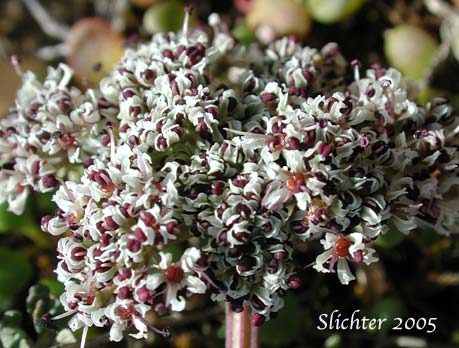 The
photo at right shows the densely compacted umbel of Canby's desert parsley as
seen atop the Dalles Mt. in the Columbia Hills in the eastern Columbia River Gorge........February
5, 2005.
The
photo at right shows the densely compacted umbel of Canby's desert parsley as
seen atop the Dalles Mt. in the Columbia Hills in the eastern Columbia River Gorge........February
5, 2005.
The name given to Canby's desert parsley by the Spokane Indians was Chucklusa.
Canby's desert parsley is a small perennial wildflower with a tuft of basal leaves and one to several, leafless, ascending or suberect scapes from 10-20 cm high. The leaf petioles all attach near or below the groundlevel. The surfaces of the leaves and stems are glabrous and somewhat glaucous. The leaves range from 5-15 cm long, including the petioles. The leaves are pinnately to ternate-pinnately dissected into many small, crowded, round or blunt segments usually not greater than 5 mm long (See photo at right.).
The flowers are arranged in an umbel, the 5-16 stems supporting the individual umbellets elongating unequally from 2.5-7 cm long. The pedicels are 4-15 mm long in fruit. The flowers are white with purple cast due to the purplish anthers. The bracts below the umbellets are minute, narrow, and measure from 1-3 mm long. The glabrous fruits are broadly elliptic with wings about one-half as wide as the body and measure 6-11 mm long.
Canby's desert parsley may be found in dry, open, rocky places in the lowlands.
Canby's desert parsley may be found from Kittitas, Douglas, and Lincoln Counties of central Washington south to northern Oregon and east to Nez Perce County in Idaho.
In the Columbia River Gorge, it may be found between the elevations of 200'-2400' from the Klickitat River east through the Columbia Hills to near Haystack Butte.